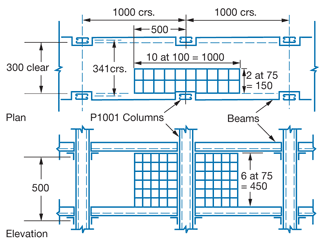Unistrut Sections as Columns
The load capacity of Unistrut Sections acting as columns depends on:
- the particular section used.
- the actual height of the column, measured between centres of connections to horizontal members.
- the location of the resultant axial load with respect to the centre of gravity, CG, of the section (i.e. the intersection of the XX and YY axes as shown on the section diagrams).
- the restraint to various kinds of movements of the column offered by the connections to horizontal members at various levels.
If a) and b) are known and if c) and d), for the case being considered, match the conditions in Structural Data Notes then the load capacity of the section can be read directly from the tables under ‘maximum column load’.
It is emphasised that, for tabulated values to be used directly, the resultant load must be concentric (i.e. act through the C.G.) and connections at each end of a free column height must restrain those ends from both horizontal and torsional movement. If these conditions do not apply, reference should be made to the appropriate sections of AS/NZS 4600 since it is most likely that a smaller value than the listed one should be used.
Example 3
Island-type storage shelving is to be constructed using P1001 main posts (columns) at 1000 x 341mm centres. Shelves are to be at 500mm vertical spacing starting from the floor and connected to the posts so that concentric loading and translational and torsional restraint are provided at each level under full load conditions.
If the shelves are to carry packages of bolts stacked six high per shelf and the packages measure 75 x 75 x 100mm with a mass of 6.5kg each, what is the maximum height (number) of shelving that can be used?
|

Step 1
- Determine Concentric load for shelf.
- Plan area supported by each main column = 1000 x 150 = 150 000mm2
- This area can be packed with 20 packages 75 x 100mm in plan i.e. 120 packages per shelf.
Hence mass per shelf = 6.5 x 120kg
and load per shelf = 6.5 x 120 x 0.0098
= 7.64kN per column.
Step 2
- Determine load capacity of P1001 section.
From P1001 Beams and Columns Table in this Tab
Section for P1001 with height 500mm.
Maximum column load = 94.09kN.
Step 3
- Determine number of shelves.
- Divide column load capacity by the load per
shelf.
i.e. Number of shelves = 94.09/7.64 = 12.31
- Hence maximum number of shelves = 12
i.e. max. height of shelving = 12 x 0.5 = 6.0 metres.
Note : If the bottoms of the columns bear onto P1000 bearers, which in turn are fixed to the ground, the load capacity of the column would be determined by the Recommended Bearing Load, (refer to Safe Bearing Loads in this Tab Section) of 30.3 kN. The number of shelves would then be given by: 30.3/7.64 = 3.96
i.e. 3 shelves, totalling 1.5 metres high.
|
